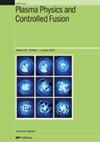Design concept of intelligent integrated control system for neutral beam injection
IF 2.1
2区 物理与天体物理
Q2 PHYSICS, FLUIDS & PLASMAS
引用次数: 0
Abstract
Due to the specificity of neutral beam injection (NBI) system, the control of its actual physical system is achieved by the integrated control system (ICS). The current NBI ICS adopts a distributed design structure to balance the system load, which is also the mainstream system design and architecture model of ICS around the world. However, from a practical point of view, the distributed system architecture is not perfect. In the long run, upgrading the system intelligence and automation capabilities is an inevitable choice for the future, so it is necessary to explore ways to transform and upgrade the ICS. At present, Internet of Things (IoT), as an important part of the new generation information technology, can realize the control of everything through data exchange. This is because on the one hand, IoT has wide compatibility and powerful scenario-based capabilities, it not only has the advantages and characteristics of distributed design, but also can pull the NBI subsystems into the same level scenario and lay the foundation for the further construction of digital NBI; on the other hand, the intervention of artificial intelligence makes IoT have some new typical characteristics such as intelligent sensing, ubiquitous connectivity, precise control, digital modeling, real-time analysis and iterative optimization, which is enough to pull the current NBI ICS into a new intelligent control era. Finally, it is worth mentioning that due to its inherent design structure and functional characteristics, ICS tends to be broadly generic, so it is not exclusively used for NBI operation in nuclear fusion, and it can provide some insight into other application areas.中性束注入智能集成控制系统的设计理念
由于中性束注入(NBI)系统的特殊性,其实际物理系统的控制由集成控制系统(ICS)实现。目前的 NBI 集成控制系统采用分布式设计结构来平衡系统负载,这也是目前世界上集成控制系统的主流系统设计和架构模式。但从实际情况来看,分布式系统架构并不完美。从长远来看,提升系统智能化和自动化能力是未来的必然选择,因此有必要探索综合布线系统的转型升级之路。当前,物联网作为新一代信息技术的重要组成部分,可以通过数据交换实现对万物的控制。这一方面是因为物联网具有广泛的兼容性和强大的场景化能力,它不仅具有分布式设计的优势和特点,还能将NBI各子系统拉入同级场景,为进一步建设数字化NBI奠定基础;另一方面,人工智能的介入使得物联网具有智能感知、泛在连接、精准控制、数字建模、实时分析、迭代优化等一些新的典型特征,足以将当前的NBI ICS拉入一个全新的智能控制时代。最后值得一提的是,由于其固有的设计结构和功能特点,ICS往往具有广泛的通用性,因此它并不完全用于核聚变中的NBI运行,它可以为其他应用领域提供一些启示。
本文章由计算机程序翻译,如有差异,请以英文原文为准。
求助全文
约1分钟内获得全文
求助全文
来源期刊

Plasma Physics and Controlled Fusion
物理-物理:核物理
CiteScore
4.50
自引率
13.60%
发文量
224
审稿时长
4.5 months
期刊介绍:
Plasma Physics and Controlled Fusion covers all aspects of the physics of hot, highly ionised plasmas. This includes results of current experimental and theoretical research on all aspects of the physics of high-temperature plasmas and of controlled nuclear fusion, including the basic phenomena in highly-ionised gases in the laboratory, in the ionosphere and in space, in magnetic-confinement and inertial-confinement fusion as well as related diagnostic methods.
Papers with a technological emphasis, for example in such topics as plasma control, fusion technology and diagnostics, are welcomed when the plasma physics is an integral part of the paper or when the technology is unique to plasma applications or new to the field of plasma physics. Papers on dusty plasma physics are welcome when there is a clear relevance to fusion.
 求助内容:
求助内容: 应助结果提醒方式:
应助结果提醒方式:


